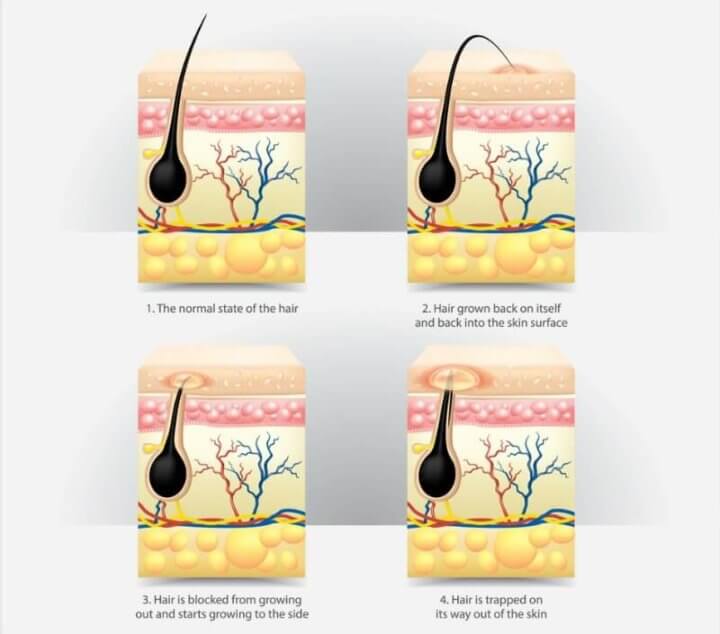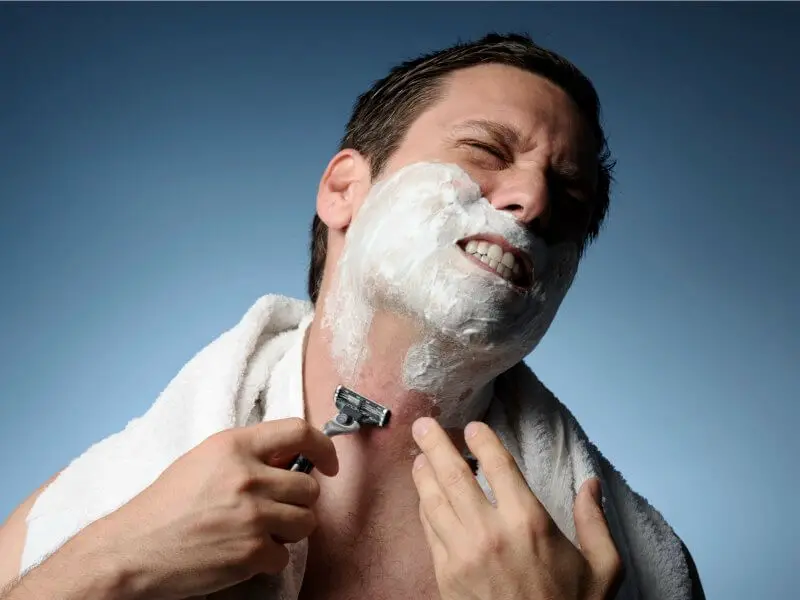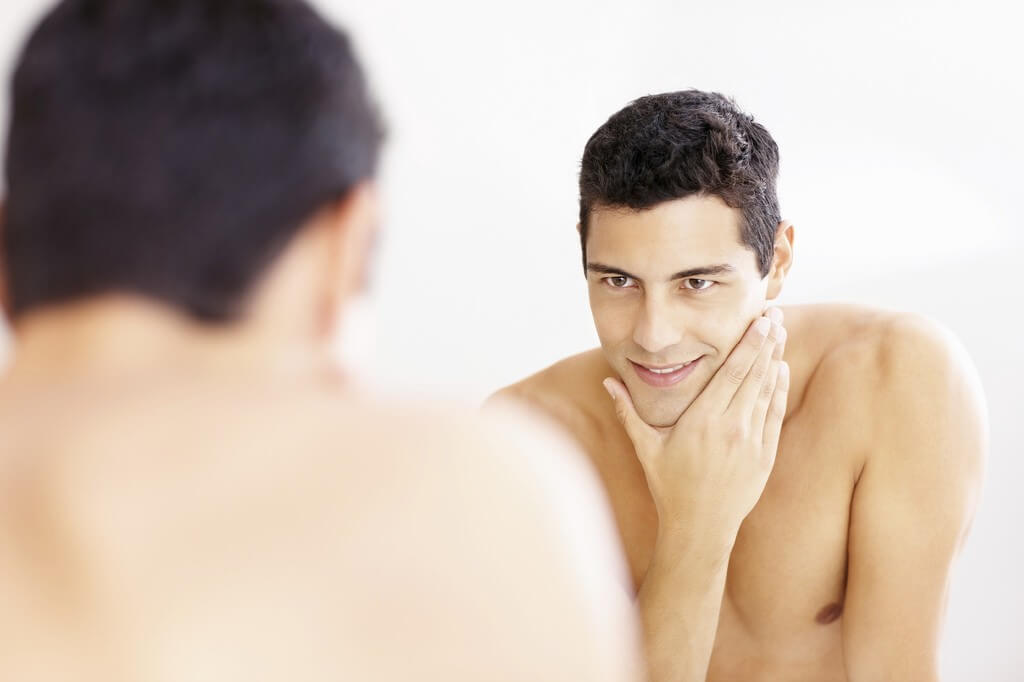
Are you plagued with ingrown hairs from shaving your face? Here are ten strategies (plus a bonus) you can take–before, during, and after the shave–to keep those painful, unsightly outbreaks at bay.
Factors That Contribute To Ingrown Hairs
Anyone (everyone?) can get the occasional ingrown hair from shaving. But there are some factors that might predispose someone to making ingrown hairs more likely:
Curly Hair
Curly hair is more likely to curl back and re-enter the skin, particularly after it’s been cut.
Ethnicity
Medical Conditions
People with high levels of certain sex hormones (Gonadotropins, Androgens, Cortisol) or those with hyperthyroidism can have excessive hair growth, which can make ingrown hairs more likely.
Skin That Is Too Dry Or Too Oily
People with very dry skin or very oily skin may be more likely to get ingrown hair. Those with skin that is too dry may have a lot of dead skin cells which may cover the skin’s pores, preventing the hair from getting to surface. Those with very oily skin can have the oil create a similar blockage.
Poor Hygiene
As you might suspect from the prior paragraph, if your skin is dirty pores can get blocked. Poor hygiene can make ingrown hairs much more likely.
So what can you do to avoid the problem? There are a number of things you can do during each stage of the shaving process:
Before Shaving

1. Adequate Hygiene
Wash the area to be shaved with a good soap or liquid cleanser that is specifically made to clean the face. Why? “deodorant bars” or “body bars” are soaps that tend to strip away too much of the skin’s natural oils that are needed for aiding the lubrication of shaving lather. Use lots and lots of warm water.
To clean more thoroughly use a washcloth or try a powered cleaning brush like this highly-rated brush. However be aware that many of these brushes (particularly the less expensive ones) do not provide enough torque to do a good job. The Art Of Shaving “Power Brush” is similar in look to other powered cleaning brushes, however the AoS brush’s three-speed motor has more torque. And AoS specifically targets its brush as a razor bump/ingrown solution:
“The Power Brush reduces the occurrence of ingrown hairs and razor bumps significantly within the first month* and delivers up to a 69% reduction in the occurrence of razor bumps**. Use the Power Brush with The Art of Shaving Pre-Shave Gel for a gentle exfoliation and massage to the skin. Together it helps increase the release of ingrown hair by up to 85% over the course of 12 weeks. This dual-purpose brush can also be used with a cleanser to deliver daily or deep cleaning and exfoliation.”
2. Occasional Exfoliation
Once or twice per week (leave at least three days between applications) try an exfoliation product like one of these. Exfoliation can do away with dead skin along with dirt which does not go away with an everyday wash. Another benefit of exfoliation is that hair follicles are softened by it, resulting in an easier shave. For normal or combination skin types use a gel-based scrub or cream-based scrub.
(Exfoliating too much may damage your skin! Your skin is also likely to become more sensitive to the sun, if exfoliated unnecessarily. So don’t overdo it.)
3. Do Not Use A Shaving Product From A Pressurized Can
All other things being equal, using a shaving cream, foam, or gel from a pressurized can is the least desirable option. Why? The propellant will tend to dry out the skin, providing the circumstances for an ingrown. Instead use a “brushless” product from a squeeze tube, or better yet, a lathering soap or cream with a brush.
4. Use A Shaving Brush
Using a shave brush produces a mild exfoliating effect on the skin: think of it as helping sweep away tiny bits of debris from around hair stubble. Shave brushes may also help lift out stubborn ingrown hairs. Using a shaving brush helps mix shaving cream or soap with water, not only making an even more effective lather for the razor blade edge to track on but also reducing the amount of air in the lather as well, preventing the skin from prematurely drying and possibly causing irritation.
During Shaving

5. Use A Razor With Fewer Blades (Or A Single Blade!)
Multi-blade cartridges use the “lift and cut” concept which in itself is often a cause of ingrown hair. Using a five blade cartridge razor? Try a three blade. Or, better yet, use a razor with a single blade! With the proper products and techniques you will get a shave just as close (maybe even closer) with less irritation.
6. Use A Razor With A Sharp Blade
A dull razor blade or cartridge will cut the hair less cleanly, increasing the likelihood of an ingrown hair. Don’t use a razor beyond its useful life.
7. Use The Concepts Of Grain And Beard Reduction
Knowing how the hair grows is essential to a good shave because it allows you to remove more hair per stroke with less chance of irritation, providing more beard reduction more quickly. Understanding beard growth is essential when using a multi-blade razor! It is less important when using a single blade razor but still important.
Grain is also important to know so that if you decide to pull the skin taut to shave you can know which direction to pull. Over-stretching the skin makes the possibility of irritation or ingrown hairs much more likely.
Shave in passes, with each pass progressively removing hair more closely to the skin. Even multi-blade razors with their “lift and cut” theory (though some might say it’s more like “yank and hack”) follow this technique, along with the “grain.”
The first pass should always be “with the grain.” Then rinse briefly, relather, and shave across the grain (90 degrees off). You may be tempted to relather and then shave against the grain but if you are susceptible to ingrown hair a better solution may be to shave across the grain from the opposite direction as the previous pass.
After Shaving

8. A Warm Rinse Followed By A Toner Wipedown
After finishing most shavers splash on a bit of cool water and apply an aftershave balm then go on about their day. Instead try a very thorough warm water rinse. Follow this by soaking a cotton pad with witch hazel, a mild toner (I like Lucky Tiger’s After Shave And Face Tonic), or a rose hydrosol, and wiping the shaved area. Then go ahead with a quick cool water rinse. This will help wash away any lather residue that might be left on the skin and possibly clogging pores.
In my own case this one strategy has virtually eliminated ingrown hairs!
9. Aftershave Products
Select an aftershave product that is less likely to clog pores. Avoid heavy aftershave balms, waxes, or gels that may dry into a heavy layer. Rather, consider a lighter aftershave balm or low alcohol “splash.”
10. Specialized Treatments
If you continue to be troubled with ingrown hairs, try a specialized treatment such as Grooming Lounge’s The Shavior, Anthony Logistics Ingrown Hair Treatment, or Jack Black’s Bump Fix.
Bonus: If You Get An Ingrown Hair Anyway
If you get an ingrown anyway, some people have gotten excellent results by using a soft (dry) toothbrush on the area just before going to bed: it exfoliates the skin just enough to expose the ingrown through the skin so it grows back out (I’ve tried this myself and it works great for me!). If its more serious it might be time to investigate a product like Tend Skin (or for a DIY alternative of a crushed plain aspirin tablet and a few drops of water. Apply to the area and let it sit for five minutes, then wash it off).
Amazon links are affiliate.

…..I forgot to add that I use a low density, synthetic shaving brush with a face wash during showers.
This is great advice.
I for one have never been able to comprehend the use of cold water, for the purpose of ‘closing/shrinking’ pores after you shave. Doesn’t that just aid the hairs to get trapped under the skin?
While I am still going through the trial and errors to completely eliminate this dreaded issue, I have found that a mild yet very efficient razor has subsided the problem by leaps and bounds. My current choices are the Karve Christopher Bradley razor with plate B, Perma Sharp blades; and the Paradigm Ti SE with Schick proline blades. I also wash thoroughly after each shave to ensure that all residue has been removed before using a toner (chatillon lux is amazing) or a ‘lower than most’ alcohol splash that contains skin nourishing properties, such as Maol Grooming.
Some great advice here, Mark.
The only point that I’d take issue with is the use of any astringent like Witch Hazel on a freshly shaved beard. Our knowledge of natural oils and their cleansing/toning properties has progressed to the point that much kinder oils are available that doesn’t cause ‘stinging’.
Remember, the pain process is there for a reason. It’s the brain telling us to stop doing what we’re doing as we’re causing damage!
Using products like Witch Hazel on a freshly-shaved beard in 2018 has more to do with tradition than science…..
I suffered from ingrown hairs, for much of my life. Many of the recommendations here, are what helped me conquer them—at least for the most part.
I found along with using better lather products, and a brush, a good preshave oil (or gel) went a long way in preventing ingrown hair problems. Just thought I’d pass that along.
I should have added one more thing that really helped me get past ingrown hairs:
Shaving in the shower!
I was reminded of that this afternoon when, due to circumstances beyond my control, I was forced to shave at a sink. Everything went fine. But it brought back memories, and now I recall how much of a difference moving to that moisture-filled environment meant to my face.
I was plagued with ingrown hairs from the time I started shaving as a teenager til I was in my early 30’s. They all grew at a certain level at the bottom of the beard level on my neck. I bit the bullet and went to an electrolysis clinic. I had treatments once or twice a week for two months until all the hair on that level was gone. I’ve never had an ingrown hair again and I’m now 73.
Thanks for the good article. I like a 3-pass shave but was having the shave bump problem. I still tilt my head and contort my muscles but I ceased using my hand to stretch my skin. My shave bump and shave-burn problems have virtually disappeared.
Those are all excellent suggestions Mark. I use your routine daily. Even though it’s time consuming (although it’s also a relaxing Zen-Like experience), it’s effective in reducing razor bumps and ingrown hairs.
One other thing that I’ve recently started using is the Supply Provision Single Edge Injector razor. I have an extremely sensitive face and since using this razor (about a month now) I’ve not had a single bump or ingrown hair. Just a thought.
Thanks for all of your excellent suggestions and for your personal help along the way.
Regards,
Dick Hirsch
Porter Ranch, California
Nice post very helpful, thanks.
Great strategies, bravo Mark!??
Ezio
Comments are closed.